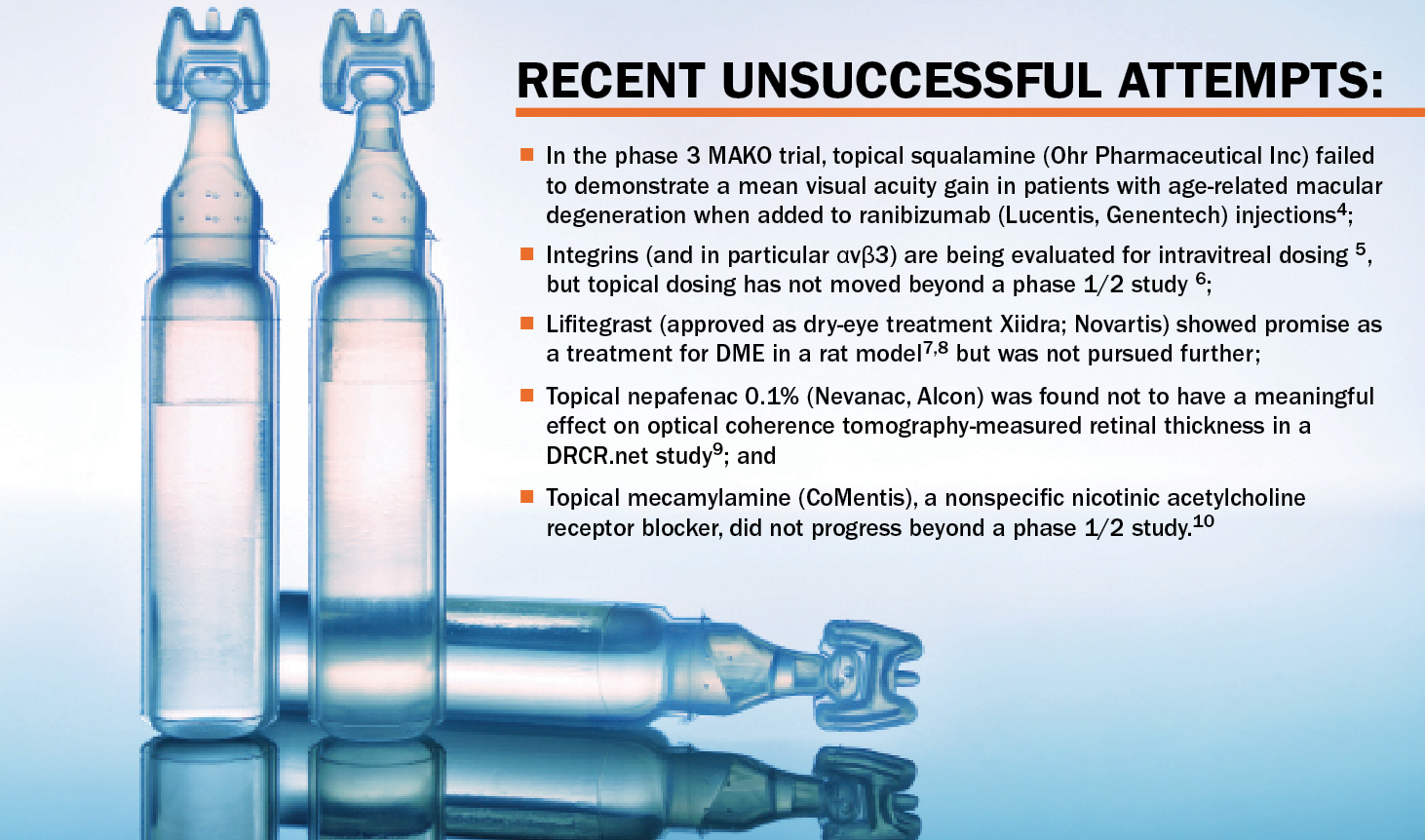The posterior segment: In search of topical treatment options
Novel therapies are shifting the paradigm in care of retinal diseases

Intravitreal treatments have revolutionized the treatment of retinal diseases, enabling drugs to bypass the many barriers that protect the eye and be delivered where they are needed. We have learned, however, that they come with a significant treatment burden for the patient and potentially also for the patient’s caregivers.
It has been well demonstrated in clinical practice that patients with diabetic macular edema (DME) undergo fewer anti-vascular endothelial growth factor (VEGF) injections and exhibit worse visual gains in the real world compared with patients in randomly assigned clinical trials. Over time, some patients become anxious about their injections, which may lead to poor compliance. Others may not have easy access to current treatments because of reimbursement issues, according to the particular healthcare system in their country of residence.
There can also be logistical challenges for patients such as the need to find somebody to drive them to the clinic to have their injections or simply the problem of not being able to afford to take a day off work. All these factors mean that even when patients are vigilant about clinic visits, some do not benefit fully from intravitreal injections and have either ongoing vision loss and/or poor anatomic responses.
An eye drop that could deliver treatment to the posterior segment would be one way to alleviate some of these challenges. This ever-elusive treatment remains the holy grail of ocular drug delivery as the search for less-invasive treatment methods continues. A topical, non-invasive, self-administered treatment would undoubtedly expand the proportion of diagnosed patients we treat as well as the number of ophthalmologists who could provide treatment.
Recent-onset DME
Diabetes and its complication diabetic retinopathy is an ongoing public health issue that shows no sign of abating. There is little debate that intravitreal injections of steroids and anti-VEGF treatments have improved vision and anatomic outcomes for many with DME.
As clinicians, we tend to observe patients with early disease until clinically significant visual impairment occurs and only then do we restore their vision, often partially, with intravitreal injections. Since these treatments are invasive and not without their own challenges, the benefit/risk ratio may not be justified in earlier stages of the disease.
A topical eye drop may present new possibilities, particularly for patients with recent-onset DME who still have good vision. Indeed, there is the possibility that by using a topical treatment in lieu of an invasive one, we can start treating patients earlier. The ability to vary the dose by varying the number of drops is an additional benefit.
The reduced treatment burden would be attractive to patients, who would still need to be monitored for disease progression but could look forward to fewer and less painful visits. And topical medications would also reduce negative psychosocial impacts associated with injection fears or phobias.
From the clinician’s point of view, patients would now only need to be requested to refill prescriptions and remember to instill drops, an easier request than asking them to attend clinics for injections. Furthermore, it would reduce the reliance on retina specialists or trained ophthalmologists to administer the treatment.
Since patients would be motivated to reduce their need for intravitreal injections, in addition to preserving and/or improving their vision, a topical treatment for posterior segment diseases should have a much higher compliance and adherence rate than treatment for glaucoma, which is often asymptomatic.1–3
Topical treatments past and present
Unfortunately for those with retinal disorders, despite all the obvious benefits of topical treatments, delivery of therapeutics to the posterior segment is still not possible. The obstacles to reaching the retina with a topical treatment are numerous: limited solubility of lipophilic drugs in aqueous eye drops and the tear film, short contact time on the surface, and lipid membrane barriers.
These barriers have not stopped researchers from trying. However, until recently, attempts have been unsuccessful.

Scientists are working on ways to overcome the issues with topical delivery of therapeutics to the posterior segment—and are starting to have some success. One therapeutic in development for DME, OCS-01 (Oculis), is a high concentration of dexamethasone in a solubilizing nanoparticle (SNP) aggregate formulation. Novel SNP-based formulations have been shown to achieve better penetration over longer periods of time by creating smartly crafted drug–cyclodextrin complexes that create a highly concentrated drug suspension that is able to deliver the drug for a prolonged period.11,12
Dugel et al.13 recently presented positive data from a Phase 2 study that evaluated 144 patients randomly assigned to either OCS-01 or vehicle. Mean central macular thickness (CMT) showed a greater decrease from baseline in the OCS-01 group than the vehicle arm at Week 12 (−53.6 μm vs −16.8 μm, P = 0.0115). Mean CMT also showed significant differences between groups in favor of OCS-01 at all visits from Week 2 to Week 12.
Mean change in Early Treatment Diabetic Retinopathy Study letter score from baseline to Week 12 was higher in the OCS-01 group than the vehicle group (+2.62 letters vs 1.04 letters, P = 0.125). P values met the prespecified criteria in the protocol for statistically significant superiority of OCS-01 versus vehicle and the compound is now moving into Phase 3 studies.
In the case of OCS-01, we know from other commercialized products that dexamethasone is an effective anti-inflammatory agent, so this is a test for the eye drop administration route. Although OCS-01 is the furthest along and shows the most promise (to date) as a topical treatment for DME, there are also other agents in earlier phases of development that may prove equally efficacious in the future, ranging from topical nonsteroidals and corticosteroids14 to cell-penetrating peptides,15 and even a Rho-associated coiled-coil containing protein kinase (ROCK) inhibitor already approved for the treatment of glaucoma and ocular hypertension.16
Prospects
If any of these topical treatments is successful in later-stage studies, the potential is great. Topical drops may let us delay initiating anti-VEGF injections and/or more invasive treatments or prolong the time to the next injection for those already undergoing intravitreal treatment. We may even be able to better co-manage patients with other healthcare providers because there is no need for specialized training beyond proper candidate screening.
I continue to look forward to the day when our armamentarium for posterior segment disorders includes topical treatments that are efficacious and safe, that substantially reduce the treatment burden for both the clinician and the patient, and that can be widely adapted across all socioeconomic and geographic boundaries.
References
Robin A, Grover DS. Compliance and adherence in glaucoma management. Indian J Ophthalmol. 2011;59(suppl):S93-S96.
Robin AL, Covert D. Does adjunctive glaucoma therapy affect adherence to the initial primary therapy? Ophthalmology. 2005;112:863-868.
Robin AL, Novack GD, Covert DW, et al. Adherence in glaucoma: objective measurements of once-daily and adjunctive medication use. Am J Ophthalmol. 2007;144:533-540.
Ohr Pharmaceutical Inc. Ohr announces efficacy results from the MAKO study in wet-AMD. 5 January 2018. Accessed 10 November 2020. https://www.globenewswire. com/News-Release/2018/01/05/1284092/0/En/Ohr- Pharmaceutical-Announces-Efficacy-Results-from-the-Mako-Study-in-Wet-Amd.html.
Allegro Ophthalmics. Allegro Ophthalmics announces positive topline vision results of phase 2 study evaluating risuteganib in patients with intermediate dry age-related macular degeneration. 4 June 2019. https://www. Allegroeye.Com/Allegro-Ophthalmics-Expands-Its-Anti- Integrin-Portfolio-with-New-Front-of-the-Eye-Drug- Candidate-Alg-1007-for-the-Treatment-of-Dry-Eye- Disease-3-2-2/.
Raab-Westphal S, Marshall JF, Goodman SL. Integrins as therapeutic targets: successes and cancers. Cancers (Basel). 2017;9:9.
Wenick AS, Bressler NM. Diabetic macular edema: current and emerging therapies. Middle East Afr J Ophthalmol. 2012;19:4-12.
Rao VR, Prescott E, Shelke NB, et al. Delivery of SAR 1118 to the retina via ophthalmic drops and its effectiveness in a rat streptozotocin (STZ) model of diabetic retinopathy (DR). Invest Ophthalmol Vis Sci. 2010;51:5198-5204.
Friedman SM, Almukhtar TH, Baker CW, et al. Topical nepafenec in eyes with noncentral diabetic macular edema. Retina. 2015;35:944-956.
Campochiaro PA, Shah SM, Hafiz G, et al. Topical mecamylamine for diabetic macular edema. Am J Ophthalmol. 2010;149:839-851.e1.
Loftsson T, Jansook P, Stefánsson E. Topical drug delivery to the eye: dorzolamide. Acta Ophthalmol. 2012;90:603-608.
Jóhannesson G, Moya-Ortega MD, Ásgrímsdóttir GM, et al. Kinetics of γ-cyclodextrin nanoparticle suspension eye drops in tear fluid. Acta Ophthalmol. 2014;92:550-556.
Dugel P, Group D-S. The Oculis OCS-01 Phase 2 Study: an effective topical therapeutic for DME. Angiogenesis, Exudation, and Degeneration Symposium 2020. Miami, FL: University of Miami Miller School of Medicine, 2020.
Or CM, Gallagher JR, Fang Z, Reinoso M. The use of topical steroids and NSAIDs in the treatment of diabetic macular edema. Invest Ophthalmol Vis Sci. 2020;61:4884.
Pescina S, Ostacolo C, Gomez-Monterrey IM, et al. Cell penetrating peptides in ocular drug delivery: state of the art. J Control Release. 2018;284:84-102.
Minami Y, Song YS, Ishibazawa A, et al. Effect of ripasudil on diabetic macular edema. Sci Rep. 2019;9:3703.
Ramin Tadayoni, MD, PhD
E: ramin.tadayoni@gmail.com
Tadayoni is professor of ophthalmology at Université de Paris, France, and head of department at Lariboisière, Saint Louis and Adolphe de Rothschild Foundation Hospitals Paris. He is a European Society of Retina Specialists (EURETINA) board member, past president of the French-speaking Retina Specialists and the leader of RHU EviRed, a national artificial intelligence project on diabetic retinopathy supported by the French government. Prof. Tadayoni is a consultant to Zeiss, Alcon, Bausch + Lomb, Moria, Allergan, Bayer, Novartis, Roche/Genentech, Thea and Oculis. Writing assistance for this article was provided by Michele Dalton from Dalton and Associates; the funding for this assistance was provided by Oculis.
Newsletter
Keep your retina practice on the forefront—subscribe for expert analysis and emerging trends in retinal disease management.